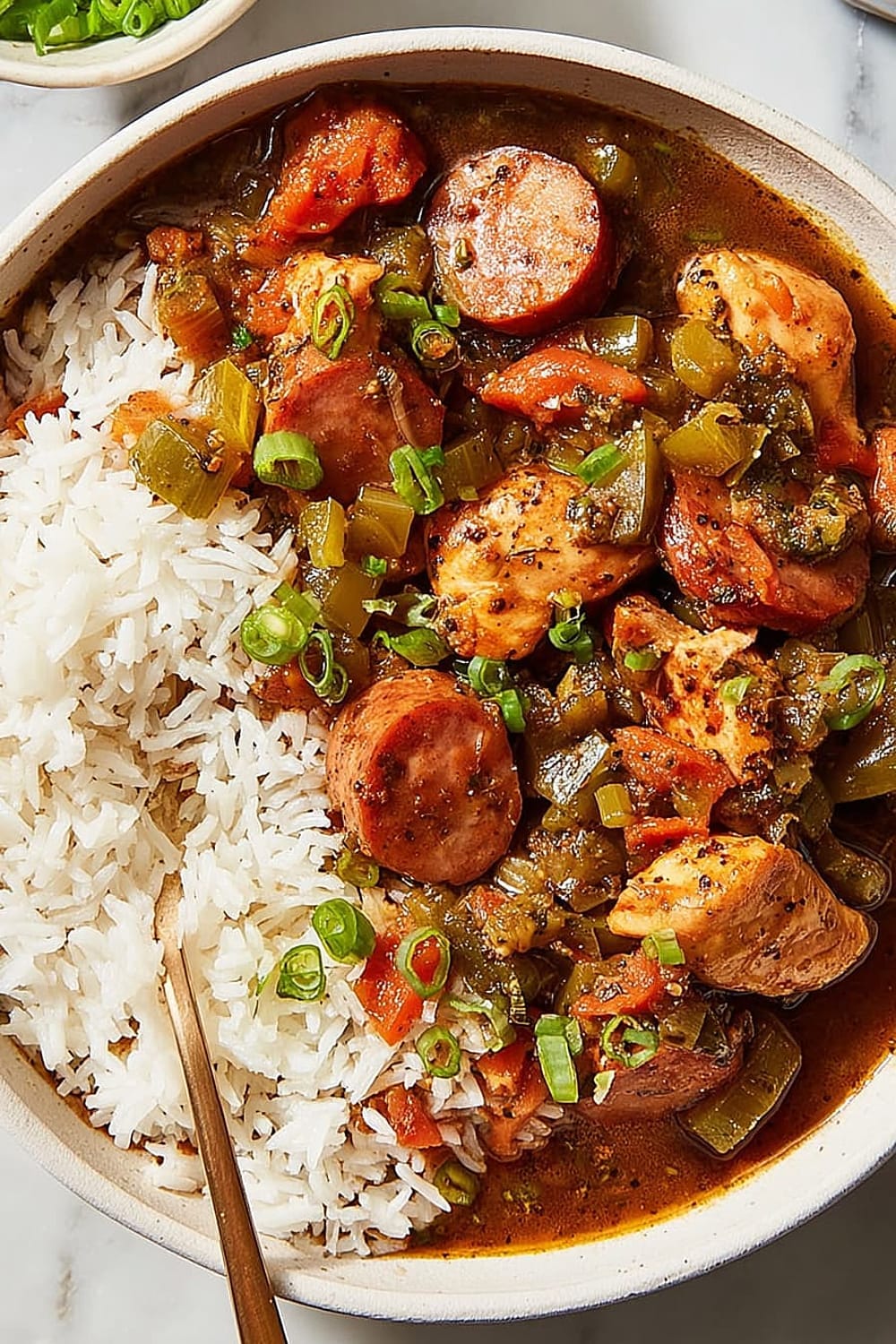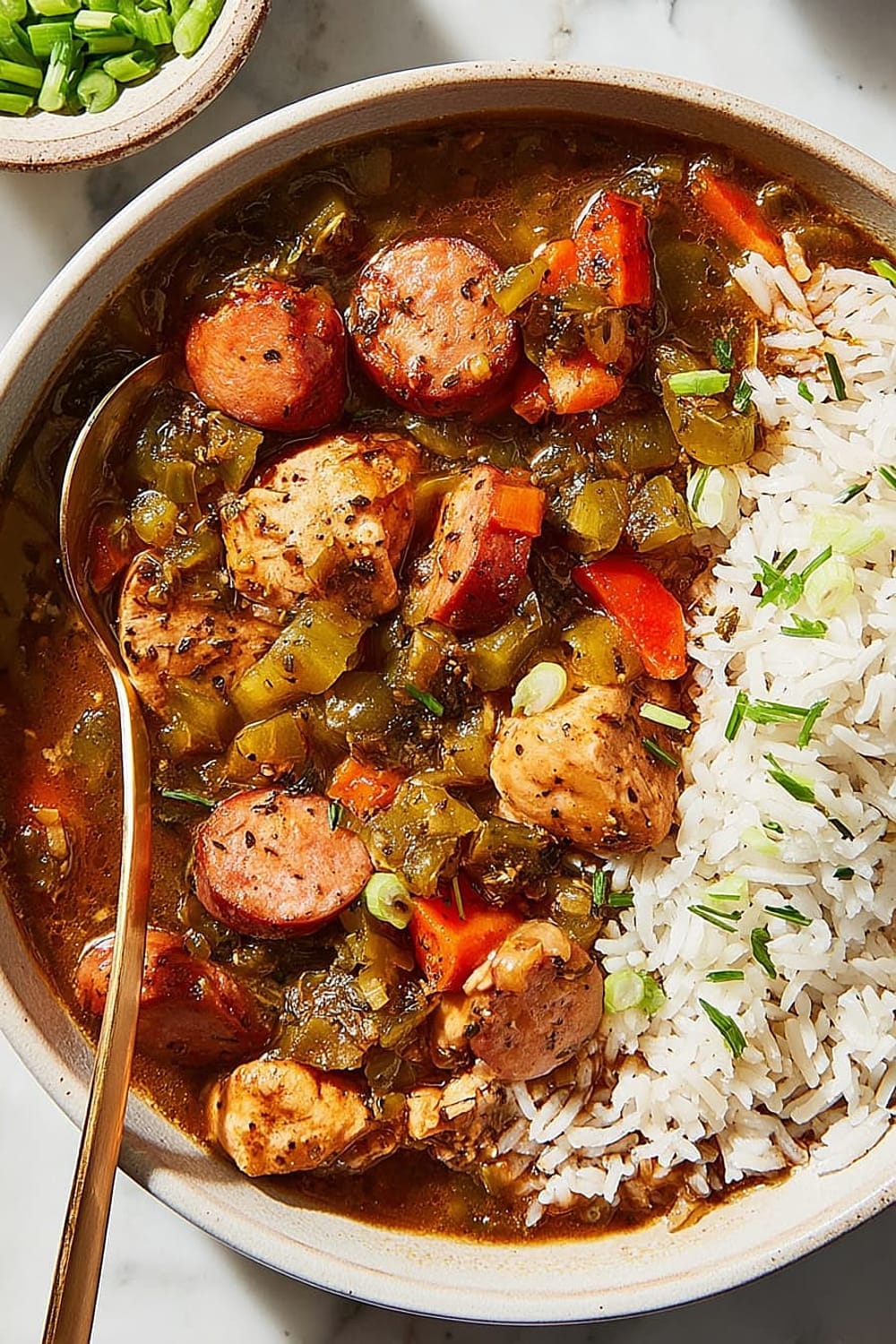Classic Cajun Gumbo

This gumbo is basically a warm hug in a bowl that happens to make your kitchen smell like New Orleans threw a party and invited all the best flavors.

The magic starts with that chocolate-colored roux that’ll have you stirring like your life depends on it, because honestly, your dinner reputation kind of does.

We’re talking about tender chicken thighs, smoky andouille sausage, and the holy trinity of vegetables all swimming together in perfect harmony.

This isn’t just soup—it’s a full-blown flavor experience that’ll have people asking if you secretly went to culinary school.

The best part is watching that roux transform from blonde to deep brown while filling your house with an aroma that could probably be bottled and sold as “Instant Comfort.”

Fair warning: making this will officially promote you to the person everyone calls when they need something impressive for dinner parties.

Ingredients
For the gumbo
- 1 medium green bell pepper
- 1 medium yellow onion
- 3 stalks celery
- 6 cloves garlic
- 1 /2 bunch fresh parsley (optional)
- 2 to 3 tablespoons salt-free Cajun seasoning, divided
- 2 teaspoons dried thyme
- 2 bay leaves
- 1 /2 teaspoon cayenne pepper, plus more as needed
- 1 pound boneless, skinless chicken thighs, or 1 rotisserie chicken
- 1 1/2 teaspoons kosher salt, plus more as needed
- 1 1/2 teaspoons freshly ground black pepper
- 14 ounces andouille sausage
- 1 /4 cup plus 1 tablespoon neutral cooking oil (canola or vegetable), divided
- 6 cups (48 ounces) low-sodium chicken broth, at room temperature
- 2 teaspoons filé powder (optional)
- 4 tablespoons (1/2 stick) unsalted butter
- 1 /2 cup all-purpose flour
For serving
- 1 /2 bunch medium scallions
- 3 cups cooked white rice
- Crystal or Tabasco hot sauce

Instructions
Prepare the vegetables and aromatics
- 1 Cut the vegetables by preparing the following, placing each in the same medium bowl as you complete it: Trim and dice 1 medium green bell pepper (1 1/2 cups), 1 medium yellow onion (1 3/4 cups), and 3 celery stalks (1 1/2 cups). This classic “holy trinity” of Cajun cooking should be diced uniformly to ensure even cooking throughout the gumbo.
- 2 Prepare the remaining aromatics by placing each in the same small bowl as you complete it: Mince 6 garlic cloves; coarsely chop the leaves from 1/2 bunch fresh parsley, if using, until you have about 1/2 cup; add 2 tablespoons of the salt-free Cajun seasoning, 2 teaspoons dried thyme, 2 bay leaves, and 1/2 teaspoon cayenne pepper; stir to combine. This aromatic mixture will bloom beautifully when added to the hot roux.
- 3 Cut the chicken: If using raw chicken, dice 1 pound boneless, skinless chicken thighs into 1-inch pieces. Season with 1 1/2 teaspoons kosher salt, 1 1/2 teaspoons black pepper, and the remaining 1 tablespoon Cajun seasoning. If using rotisserie chicken, pick the meat and shred (about 4 cups); discard the skin and bones. Chicken thighs stay more tender than breasts during the long simmering process.
Cook the proteins
- 4 Cook the sausage by cutting 14 ounces andouille sausage crosswise into 1/2-inch-thick rounds. Cook in a large pot or Dutch oven over medium-high heat until the sausage is browned all over and releases its fat, about 5 minutes. Transfer the sausage to a plate. The rendered fat adds incredible flavor to the base of your gumbo.
- 5 Brown the chicken: If using raw chicken, add 1 tablespoon of the neutral cooking oil and the chicken to the pot. Cook, stirring often, until the chicken is browned all over, about 10 minutes. Using a slotted spoon, transfer the chicken to the plate of sausage. Skip this step if using rotisserie chicken, as it’s already cooked and just needs to be warmed through later.
Create the roux and build the gumbo
- 6 Cook the roux by reducing the heat to medium. Scrape up any browned bits from the bottom of the pot with a wooden spoon. Add 4 tablespoons unsalted butter, the remaining 1/4 cup neutral oil, and 1/2 cup all-purpose flour. Cook, stirring constantly and scraping the bottom of the pot with the wooden spoon, until the roux resembles the color and texture of melted milk chocolate, 10 to 20 minutes. It will go from smelling like flour to toasted popcorn to nutty coffee. Don’t turn your back on the roux or it will burn and you’ll need to start over!
- 7 Add the aromatics and meat by increasing the heat to medium-high and adding the bell pepper mixture. Stir to coat in the roux. Cook, stirring frequently, until the onions are translucent, about 10 minutes. Add the garlic mixture and return the sausage and chicken and any accumulated juices to the pot. Cook, stirring frequently, until the garlic is fragrant, 2 to 3 minutes.
Simmer and serve
- 8 Simmer by adding 6 cups low-sodium chicken broth. Increase the heat to high and bring to a boil. Reduce the heat to medium-low and simmer uncovered until the gumbo is thickened slightly and the flavors have melded, 35 to 45 minutes. Meanwhile, thinly slice 1/2 bunch scallions and cook white rice for serving if desired.
- 9 Serve by tasting and seasoning with more kosher salt as needed. You’ll likely need to add more salt if starting with rotisserie chicken. The gumbo can be served immediately or the day after (which is when it tastes best). Serve with a scoop of cooked white rice, scallions, a dash of Crystal hot sauce, and filé powder as desired. Filé powder adds herbal notes and thickens the gumbo slightly.

Recommended Equipment and Kitchen Tools
Essential Tools (for best results):
- Large Dutch oven or heavy-bottomed pot – The thick bottom prevents the roux from burning and distributes heat evenly during the long simmering process
- Wooden spoon – Perfect for stirring the roux continuously without scratching your pot’s surface
- Sharp chef’s knife and cutting board – Essential for efficiently dicing the holy trinity vegetables uniformly
- Medium and small mixing bowls – Keeps your aromatics organized and ready to add at the right moment
Helpful Upgrades:
- Immersion blender – Great for slightly thickening the gumbo if you prefer a less chunky texture
- Kitchen scale – Ensures precise measurements for the roux, which is critical for proper thickening
- Instant-read thermometer – Helps monitor the gumbo’s temperature during simmering for optimal flavor development
Nice-to-Have Options:
- Food processor – Makes quick work of dicing vegetables if you’re making a large batch
- Cast iron skillet – Perfect for browning the sausage separately if your Dutch oven gets crowded
- Fine-mesh strainer – Useful for removing bay leaves and any impurities from the finished gumbo

Recipe Variations and Dietary Modifications
Seafood Gumbo Variation:
- Replace chicken with 1 pound mixed seafood (shrimp, crab, oysters)
- Add seafood during last 10 minutes of simmering to prevent overcooking
- Use seafood stock instead of chicken broth for deeper ocean flavor
- Add 1 tablespoon Worcestershire sauce for extra umami depth
Vegetarian Adaptation:
- Replace chicken and sausage with 2 cups mixed vegetables (okra, mushrooms, bell peppers)
- Use vegetable broth and add 2 tablespoons soy sauce for depth
- Include 1 cup cooked white beans for protein and heartiness
- Double the Cajun seasoning to compensate for missing meat flavors
Gluten-Free Version:
- Replace all-purpose flour with 1/2 cup rice flour or 6 tablespoons cornstarch
- Cook roux slightly longer as alternative flours brown differently
- Ensure Cajun seasoning blend is certified gluten-free
- Serve over cauliflower rice for completely grain-free option
Spice Level Adjustments:
- Mild version: Reduce cayenne to 1/4 teaspoon and use mild Cajun seasoning
- Extra spicy: Add 1-2 minced jalapeños with vegetables and increase cayenne to 1 teaspoon
- Heat-sensitive: Serve hot sauce on the side rather than adding directly to pot

Nutritional Information and Health Benefits
Key Nutritional Highlights:
This hearty gumbo provides approximately 320 calories per serving with a balanced macronutrient profile. Each bowl delivers about 25 grams of high-quality protein from the chicken thighs and andouille sausage, 18 grams of carbohydrates primarily from the vegetables and roux, and 16 grams of fat from the cooking oils and meat. The generous vegetable content contributes 4 grams of fiber per serving, supporting digestive health and satiety.
Health Benefits of Main Ingredients:
The holy trinity vegetables (bell peppers, onions, and celery) provide significant vitamin C and antioxidants, with bell peppers alone contributing over 100% of daily vitamin C needs. Garlic contains allicin, known for its anti-inflammatory and immune-supporting properties. Chicken thighs offer complete protein plus important minerals like selenium and phosphorus. The Cajun spices, particularly cayenne pepper, contain capsaicin which may boost metabolism and provide anti-inflammatory benefits.
Dietary Considerations:
This recipe is naturally gluten-containing due to the flour-based roux and dairy-free except for the small amount of butter. It’s high in sodium from the sausage and seasonings, so those monitoring sodium intake should consider using low-sodium alternatives. The dish provides excellent B-vitamins from the meat and vegetables, supporting energy metabolism and nervous system function.

Smart Swaps and Ingredient Substitutions
Common Substitutions:
- Andouille sausage → Kielbasa, chorizo, or Italian sausage (use same amount, adjust spices accordingly)
- Chicken thighs → Chicken breasts, turkey, or duck (reduce cooking time for breasts to prevent drying)
- Fresh parsley → 2 tablespoons dried parsley or fresh cilantro for different flavor profile
- Cajun seasoning → 1 tablespoon paprika + 1 teaspoon each garlic powder, onion powder, oregano, thyme
Budget-Friendly Swaps:
- Andouille sausage → Regular smoked sausage + extra Cajun seasoning (saves about 30% on cost)
- Fresh chicken thighs → Rotisserie chicken (often cheaper per pound and saves time)
- Low-sodium chicken broth → Homemade stock from chicken bones (nearly free if using leftover bones)
Pantry Emergency Substitutions:
- Bell pepper → Frozen bell pepper strips (thaw and drain first)
- Fresh garlic → 2 teaspoons garlic powder (add with dry spices instead of fresh aromatics)
- Filé powder → 1 tablespoon cornstarch mixed with 2 tablespoons cold water (for thickening only)
Pro Tips for Substitutions:
- Store homemade Cajun seasoning in airtight container for up to 6 months
- When using frozen vegetables, add them 5 minutes later to prevent overcooking
- Leftover gumbo freezes beautifully for up to 3 months in portions

Make It Diabetes-Friendly
Flour & Carb Modifications:
- Replace 1/2 cup all-purpose flour with 6 tablespoons almond flour or 1/4 cup coconut flour
- Reduce roux cooking time as alternative flours brown faster
- Carb reduction: Saves approximately 15 grams carbs per serving
- Serve over cauliflower rice instead of white rice (saves 35 grams carbs per serving)
Portion & Timing Tips:
- Stick to 1 1/2 cup servings to manage carbohydrate intake effectively
- Estimated carbs per serving: 12 grams (with flour substitute and no rice)
- Pair with 2 tablespoons avocado or 1 ounce cheese to add healthy fats
- Best timing: Serve as lunch with a side salad to balance blood sugar impact
Sausage Modifications:
- Choose turkey andouille or chicken sausage to reduce saturated fat
- Look for nitrate-free options to avoid unnecessary additives
- Reduce sausage to 10 ounces and add 1 cup extra vegetables for fiber boost
Seasoning Enhancements:
- Add 1 teaspoon turmeric for anti-inflammatory benefits
- Include 2 tablespoons apple cider vinegar to help with blood sugar response
- Total Carb Reduction: 50 grams per serving with all modifications

Perfect Pairing Suggestions
Beverage Pairings:
This rich, spicy gumbo pairs beautifully with crisp white wines like Sauvignon Blanc or Pinot Grigio that cut through the richness without competing with the complex flavors. For beer lovers, wheat beers or light lagers provide refreshing contrast, while sweet tea or lemonade offers classic Southern comfort. Sparkling water with lime cleanses the palate between spoonfuls of this hearty stew.
Side Dish Recommendations:
Complement the gumbo’s richness with fresh cornbread or crusty French bread for sopping up every drop. Collard greens with vinegar provide a tangy contrast that cuts through the fat, while simple coleslaw adds cool crunch. Roasted okra or green beans echo the Southern theme without overwhelming the main event. Pickled vegetables offer acidic brightness that enhances the gumbo’s deep flavors.
Complete Meal Ideas:
Start with shrimp cocktail or oysters to embrace the Gulf Coast theme, then serve the gumbo as the star with warm buttermilk biscuits. Finish with bread pudding or pecan pie for authentic New Orleans flair. For casual entertaining, set up a gumbo bar with various hot sauces, extra scallions, and different rice options so guests can customize their bowls.
Occasion Suggestions:
This gumbo shines at winter gatherings, Mardi Gras celebrations, or Sunday family dinners. It’s perfect for potluck contributions since it travels well and feeds a crowd. The make-ahead nature makes it ideal for meal prep or busy weeknight dinners when you want something special without last-minute stress.

Pro Tips and Troubleshooting
Roux Mastery:
The key to perfect gumbo lies in patience with the roux. Keep the heat at medium and stir constantly—no phone checking allowed! If you see black specks, start over immediately as burnt roux will ruin the entire pot. The roux is ready when it smells nutty and reaches the color of milk chocolate. Adding room-temperature broth prevents the roux from seizing up.
Make-Ahead Strategy:
Gumbo actually improves overnight as flavors meld and deepen. Make it 24 hours ahead for best results, then reheat gently over low heat, stirring occasionally. Freeze portions in quart containers for up to 3 months—just thaw overnight and reheat slowly. Don’t add the filé powder until serving, as it can make reheated gumbo stringy.
Common Mistakes Prevention:
Never rush the roux—burnt flour cannot be saved. Don’t add cold liquid to hot roux as it will splatter dangerously. If your gumbo seems thin, simmer uncovered for an additional 15-20 minutes rather than adding more flour. Taste and adjust seasoning at the end, as the long cooking process concentrates flavors.
Storage and Scaling:
This recipe doubles easily for large gatherings—just use a bigger pot and extend cooking times slightly. Store leftovers in the refrigerator for up to 4 days, adding a splash of broth when reheating if needed. Remove bay leaves before storing to prevent them from making the gumbo bitter over time.

This gumbo represents everything beautiful about comfort food—it’s forgiving, feeds a crowd, and gets better with time, just like the best things in life.